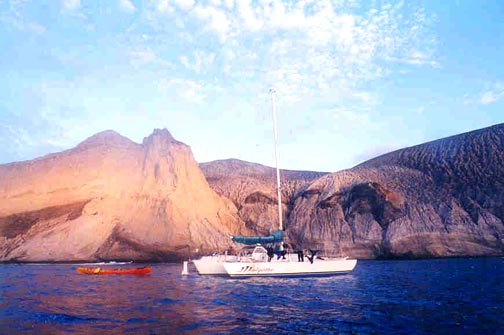
Mexican Fisheries Policy: Revillagigedos Fog Lift
![]()
|
Vince Radice's boat Windsplitter at the Revillagigedo Islands Biosphere Reserve's remote San Benedicto Island of the coast of Mexico. |
A PERSONAL OBSERVATION OF FISHERIES REGULATIONS ENFORCEMENT
AT MEXICO'S PROTECTED REVILLAGIDEDO ISLANDS
By Gene Kira, January 13, 2003, as published in Western Outdoor News:
"The fog of war" was a term coined by German military historian Karl von Clausewitz to describe the confusion that arises when commanders must make critical decisions based on fragmentary and often contradictory information coming from the front.
And that's also what it's like trying to puzzle out the status of Mexico's marine fisheries policy, based on the fog of propaganda, distortions--and once in a while--the facts that bubble to the surface.
So, it was very illuminating last week to hear from Vince Radice, of San Carlos, Sonora, Mexico, who just returned with some firsthand information from a trip to the Revillagigedo Islands aboard his 40-foot trimaran, the Windsplitter.
|
|
Last March 18, as you will recall, the islands were summarily closed to all types of fishing by the Mexican government, and ever since, we've been groping through a pea soup fog of protests, one of the most troubling of which has been that the Rivillagigedo Biosphere Reserve is now "wide open" to commercial fishing because Mexico "doesn't have the assets" to enforce its own laws at the islands without the help of the San Diego long-range fleet.
Radice's observations aboard the Windsplitter indicate--on the contrary--that the Mexican Navy is doing an excellent enforcement job at the Revillagigedos, confirming what I heard and saw last spring during trips to visit Navy Headquarters at Mexico City and the Navy detachment at Socorro Island itself.
The Windsplitter arrived at San Benedicto Island on the afternoon of December 4, and within hours, according to Radice, "a big Navy plane flew 100 feet over our mast." This was a twin-engined plane, apparently similar to the one I saw and photographed on the paved runway high atop the central ridge of Socorro Island, where it is permanently stationed.
About first light the next morning, Radice said, "a big Navy vessel passed 500 yards away, stopped, and then left." The Windsplitter was not boarded during this friendly visual inspection, but Radice said that another boat, the Namaste, was boarded that same day and had its papers checked, even though it was about 20 miles north of San Benedicto, well outside the Biosphere Reserve but still in Mexican waters.
|
|
Again, Radice said, the Navy was very friendly. "They checked papers. They were very polite," he said. "They even asked if they needed anything. They even topped off their diesel tanks for them! They said, 'call us on 16 if you need anything. We're at Socorro.'"
As he cruised around the islands for the next several days, Radice said, "Every day after that, we had a buzz by a Navy plane. There is no doubt in my mind that the patrol was coordinated. They know what's going on out there."
Radice added that this was his third trip to the Biosphere Reserve, and, "this was the first time that I didn't see commercial fishing at the south point of Benedicto. The Navy was out there doing their job. We did see the Solmar V dive boat at Socorro, no other boats at all except for a private yacht."
Radice, a qualified observer who owns the Sonoran Sport Center water sports service in San Carlos, said he saw excellent conditions at the islands with "tons of shark" and "no sharks with hooks in their mouths."
But Radice had some bad news, too, about the massive near shore longlining he saw at Puerto Vallarta. "Never saw more longlines in my life," he said. "My rudder got fouled. We went over a ton of them because we had to. They were north of PV, probably the first 30 miles, about 15 to 30 miles offshore."
And just in--an unconfirmed report of as many as a thousand pangas from the Mexican states of Sonora and Sinaloa blatantly and illegally gill netting south of El Golfo de Santa Clara inside the Alto Golfo Biosphere Reserve.
So, you win some and you lose some. Forecast for the future? Lots more fog on the way.
(Related Mexico articles and reports may be found at Mexfish.com's main Mexico information page. See weekly fishing news, photos, and reports from the major sportfishing vacation areas of Mexico including the Mexico area in "Mexico Fishing News.")
MEXICO FISHING INFO MEXICO FISHING INFO "WEEKLY MEXICO FISHING NEWS" FISH PHOTO GALLERY
